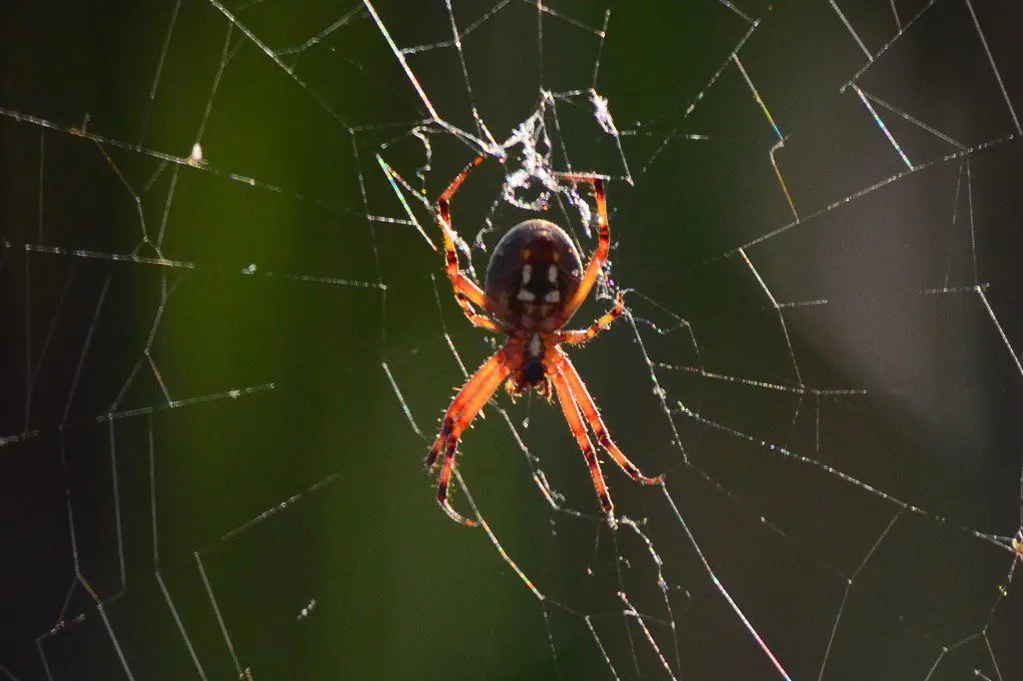The Western Spotted Orbweaver–Female

WHAT WETLANDS PARK RESIDENT IS A BORN WEBMASTER (OR MISTRESS)?
Spiders are among the most fascinating residents at Clark County Wetlands Park. I have a great deal of trouble choosing favorite spiders, but orbweavers are easily toward the top of my list! The western spotted orbweaver (Neoscona oaxacensis) is one of several orbweaver species known from the Park, and there may be more that we don’t know about yet. Perhaps we have a study opportunity for future biologists!
Western spotted orbweavers are also known as Zig-zag spiders in parts of their large range. They can be found across the Americas, from Kansas west to California and south to Venezuela and Peru, including the Galapagos Islands. Wherever they occur, they favor wetlands and fields close to water, though they occasionally will set up housekeeping in deserted buildings. The adult spiders do not overwinter, and each spring, the spiderlings from egg clutches laid the previous fall emerge in March or April. They are small and hard to see at first, but by late June, and on into October, the large, colorful adults are abundant and commonly seen.
Female western spotted orbweavers are bigger than males, with an overall length of three-quarters of an inch. Adults are highly variable in both color and pattern. In fact, it has been said that “no two specimens look alike.” Their dorsal (upper body) spot patterns are individual variations on a theme, like the stripes of zebras, and some have no spots at all! If you look at the ventral (belly) side of the spider, the pattern is more consistent, usually with detached white marks “bracketing” the sides of the abdomen and a pale sternum surrounded by dark lines. Our photo model is a good example of this. The legs may be red or yellow, but the black bands near the feet are present regardless of leg color.
Orbweaver webs are wonders of architecture and engineering, and the spiders require no higher education (in fact, no “education” at all) to create them. Each spiderling hatches knowing everything it needs to know about web design and construction. Western spotted orbweavers, like other orbweaver species, simply weave the webs they “know” how to weave, in sizes that fit the size of the spider. Adult females often choose locations four to five feet off the ground for their webs, and the prey-catching portion of the web can be anywhere from three and a half to fifteen inches across. Males also weave webs, often very near or even sharing part of an edge with the web of a female.
The work of weaving and repairing webs, feeding, and mating mostly occurs in the early morning or at night. Since the web is made of important proteins, damaged portions or even the whole web may be consumed by the spider as repairs are made. This allows the spider to “recycle” the proteins and other nutrients the silk contains. Sometimes the spiders may be seen hanging in the center of their webs in daylight. If a web looks like nobody is home, a closer look will often reveal the owner keeping out of the sun and avoiding predators at the edge of the web, hidden inside a curled leaf or similar shelter.
All that “web-work,” of course, serves a vital purpose – capturing the spider’s food. Western spotted orbweavers will dine on any flying insect that blunders into the web, including barklice, beetles, moths and butterflies, grasshoppers, and damselflies. When a trapped insect struggles, the strands of the web vibrate, and the spider rushes to bite and paralyze its prey and wrap it in silk for later consumption. When ready to dine, the spider injects digestive enzymes into its prey to make feeding easier. Once the meal is over, the spider cuts the small ball of residue remaining out of the web and repairs it, ready to catch the next meal.
Keep an eye out for orb-shaped webs suspended in the bushes or trees along Wetlands Park trails from summer into fall. You may be able to walk right up for a close look at the homeowners. For webs a bit harder to approach, close-focus binoculars are a wonderful investment!
– By Chris Leavitt, President; photo by Philip Martini
Please enjoy these YouTube videos!
Western spotted orbweaver DocWeeder’s Garage 1:20
Western Spotted Orbweaver aka The ZigZag Spider spider#newmexico 1:02
Western Spotted Orbweaver Spider devouring a Aztec Dancer Dragonfly Wild Wonders with Sushanta https://www.youtube.com/watch?v=hC7y0Bb1Te8
1:32
